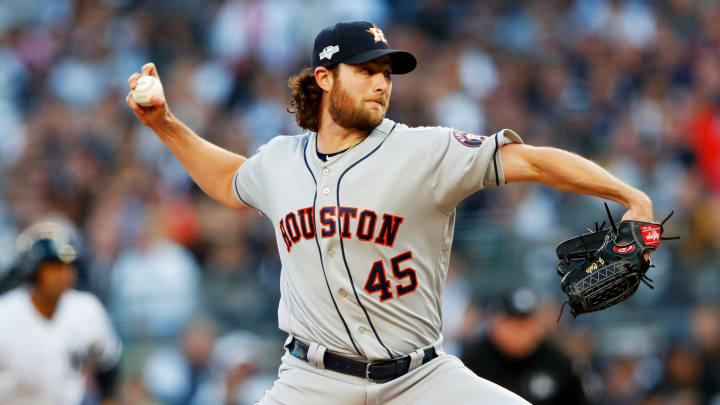Is the Baseball's Composition Influencing the Game's Economics?

Earlier this month, Gerrit Cole signed the richest deal in history for a pitcher. For the $324 million he will receive over the next nine years, he can thank his own prodigious talent, the analytically-driven coaching he got during two years with the Astros, superagent Scott Boras … and perhaps one other factor: the baseball itself.
The wild fluctuations in the sports’ most essential equipment are exasperating GMs, broadcasters and fans. They may also be influencing the economics of the game.
This has been a long time coming. Midway through the 2015 season, baseballs used in MLB games suddenly changed. Players noticed lower seams. Pitchers began reporting blisters. Most noticeably, the home run rate spiked. In ’17, the sport set a new longball record of 6,105. (The previous high, set during ’00, in the thick of the steroid era, was 5,693.) The next spring, a study commissioned by Rob Arthur, then of ESPN, found that the composition of the ball had been modified: the cores were less dense, which makes them bouncier and more likely to fly farther. Three months later, MLB bought Rawlings, which manufactures the balls, in the name of standardization. In ’19, hitters shattered the ’17 record, swatting 6,776 homers.
And then the playoffs began. Balls that in April would have been gone were in October settling safely into outfielders’ gloves. Hitters found themselves in trouble on the basepaths as they celebrated what turned out to be long singles. TV cameramen struggled to follow the unfamiliar parabolas. Fans in packed postseason stadiums could not decide whether to boo or cheer. Arthur, now at Baseball Prospectus, calculated the drag factor on the balls and found it dramatically reduced from the regular season, more like the balls of 2016. Teams began moving their outfielders in.
Through it all, MLB has insisted it has no idea what is going on. At the winter meetings this month, the league held a press conference to announce the results of its own study, a 27-page report compiled by four independent experts. It concluded that further study was required.
Should we expect the juiced ball in 2020? The regular ball? It seems that teams were unwilling to wait to find out. Fifty-six hours earlier, the Nationals had agreed to terms with Stephen Strasburg. Twenty-five hours earlier, the Yankees had agreed to terms with Cole. And 10 hours later, the Angels would agree to terms with Anthony Rendon. All signed massive deals; Strasburg and Rendon will each make $245 million over seven years. These were the consensus top three free agents, and after years of slow winters, all were off the market two weeks before Christmas.
What happened? They are all great players—and crucially, they are great players regardless of the composition of the baseball.
Cole led the league in strikeouts last year, with 326, a number no pitcher had hit since Randy Johnson was embarrassing hitters in the late 1990s and early 2000s. No righthander had done it since Nolan Ryan was embarrassing hitters in the 1970s. On a rate basis—13.8 Ks per nine innings for a starter—Cole stands alone in history. In his last three full seasons, Strasburg has ranked among the top 10 NL pitchers in strikeouts. Rendon hits the ball hard twice as often as league average. These are valuable skills no matter what the ball does: A strikeout pitcher doesn’t care how far a ball in play travels. A masher’s line drives will benefit his team whether they’re home runs or doubles.
The people most frustrated by the ambiguity surrounding the baseball are the players. Next in line are executives trying to construct a team with no idea who is valuable. Solidly in third place are the creators of projection systems.
One of those, Dan Szymborski, developed ZiPs (Szymborski Projection System), which is hosted by FanGraphs. He likens the player market to the stock market: Uncertainty tends to be followed closely by a rush to quality. People decide to invest in a product in which they can be sure.
People around the game suggest that another example of this premise might be the Padres’ seemingly incongruous signing of lefty reliever Drew Pomeranz to a four-year, $34 million deal. Pomeranz struggled mightily as a starter with the Red Sox in 2018, to the tune of 6.31 ERA. He lost his spot in the rotation in August. The transition did not help: He had a 5.56 ERA out of the bullpen. Boston traded him to the Giants, who used him exclusively as a reliever and saw his strikeout rate climb from 8.0 per nine to 10.7 per nine. He pitched so well that they flipped him at the deadline to the contending Brewers, where he struck out 15.4 men per nine. As a reliever who can generate strikeouts, the thinking goes, he might be insulated from inconsistency in the baseball’s flight path. (San Diego GM A.J. Preller demurs; the Padres just like Pomeranz, he says.)
This rush to quality might explain why elite players are getting paid quickly this year while the middle tier continues to languish: Teams believe they have outsmarted uncertainty. But maybe not so fast. “It doesn’t have to be a choice between the juiced ball and the regular ball,” Szymborksi points out. “It could be a third ball!”
